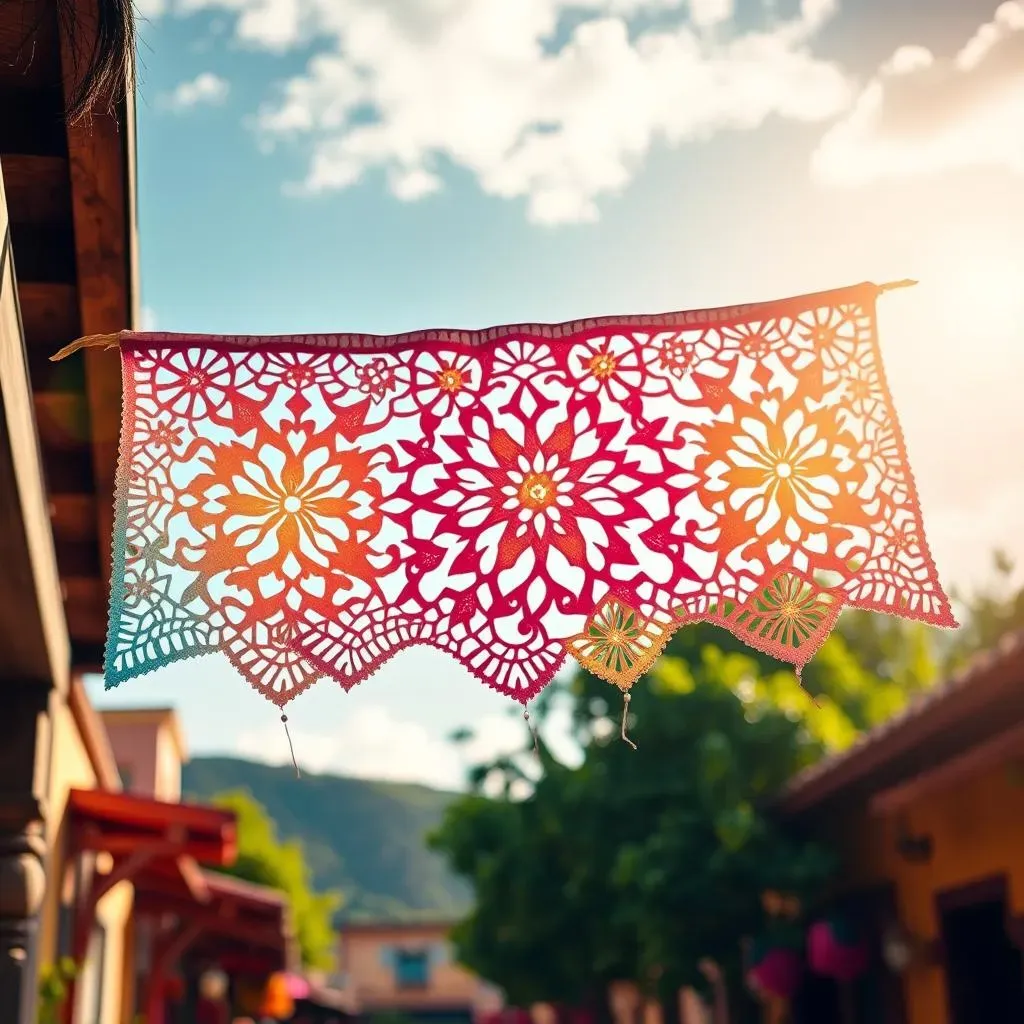Table of Contents
Ever seen those delicate, colorful paper banners fluttering in the Mexican breeze? That’s Papel Picado, a stunning example of paper cutting mexico. This isn't just any craft; it's a vibrant tradition with roots stretching back centuries. We're about to explore the fascinating world of papel picado, from its ancient origins to the skilled artisans keeping it alive today. Imagine transforming simple tissue paper into intricate designs with just a chisel and a steady hand. We’ll journey to San Salvador Huixcolotla, the town considered the heart of this art form, and uncover the cultural significance behind each delicate cut. From the materials used to the different types of papel picado for various celebrations, you'll gain a deeper appreciation for this beautiful and meaningful art form. Get ready to discover the stories behind the paper, the artists who create it, and how this tradition continues to weave its magic into Mexican culture. This is more than just paper; it's a piece of history, a celebration of life, and a testament to the power of human creativity.
The Origins of Paper Cutting in Mexico
The Origins of Paper Cutting in Mexico
The story of paper cutting in Mexico, or "papel picado," doesn't begin with paper at all. Imagine the Aztec people, centuries ago, carefully chiseling designs into the bark of trees. These weren't just random doodles; they were often spiritual figures, symbols meant to honor gods and ancestors. When the Spanish arrived, they brought with them a new material: tissue paper. This thin, delicate paper, imported from China, became a canvas for the same intricate designs, making the art form more accessible to the masses. The shift from bark to paper was a game-changer, allowing for more elaborate and colorful creations. So, while we admire the beautiful paper cuttings today, let's not forget that the true origins of the art lie in the ancient traditions of the Aztec people and their connection with nature and spirituality. It's a fascinating blend of old and new, where indigenous artistry meets imported materials.
San Salvador Huixcolotla: The Heart of Papel Picado
San Salvador Huixcolotla: The Heart of Papel Picado
A Town Dedicated to Paper
If papel picado had a capital, it would be San Salvador Huixcolotla. This small town in the state of Puebla is famous for producing some of the highest quality and most intricate paper cuttings in all of Mexico. It's not just a place where papel picado is made; it's a place where it lives and breathes. Walking through the streets, you'll see workshops on every corner, with artisans meticulously crafting their designs. The air is filled with the gentle tap-tap-tap of mallets and the vibrant colors of tissue paper hanging out to dry. It's a place where the tradition has been passed down through generations, each family adding their own unique touch to the art form. It’s like stepping into a living museum, dedicated to this beautiful craft.
The Artisans and Their Craft
What makes San Salvador Huixcolotla so special isn't just the location, it's the people. The artisans here are incredibly skilled, turning simple paper into works of art with practiced ease. They use a combination of a guide (a pattern), a small mallet, and various chisels to create these delicate designs. It’s all done by hand, no fancy machines or shortcuts. Each cut is deliberate, each design telling a story. These artisans aren't just making decorations; they're preserving a piece of Mexican heritage. They pour their heart and soul into every piece, and that passion is evident in the intricate details and vibrant colors. The dedication is tangible, and you can feel the pride they have in their work.
Tool | Description | Use |
|---|---|---|
Guide (Pattern) | A pre-designed template, often made of paper or cardboard. | Used as a guide for cutting the design into the tissue paper. |
Small Mallet | A small hammer, usually made of wood. | Used to tap the chisels, making the cuts in the paper. |
Chisels | Sharp, metal tools of varying shapes and sizes. | Used to make precise cuts in the tissue paper, creating intricate designs. |
How Paper Cutting Mexico is Made
How Paper Cutting Mexico is Made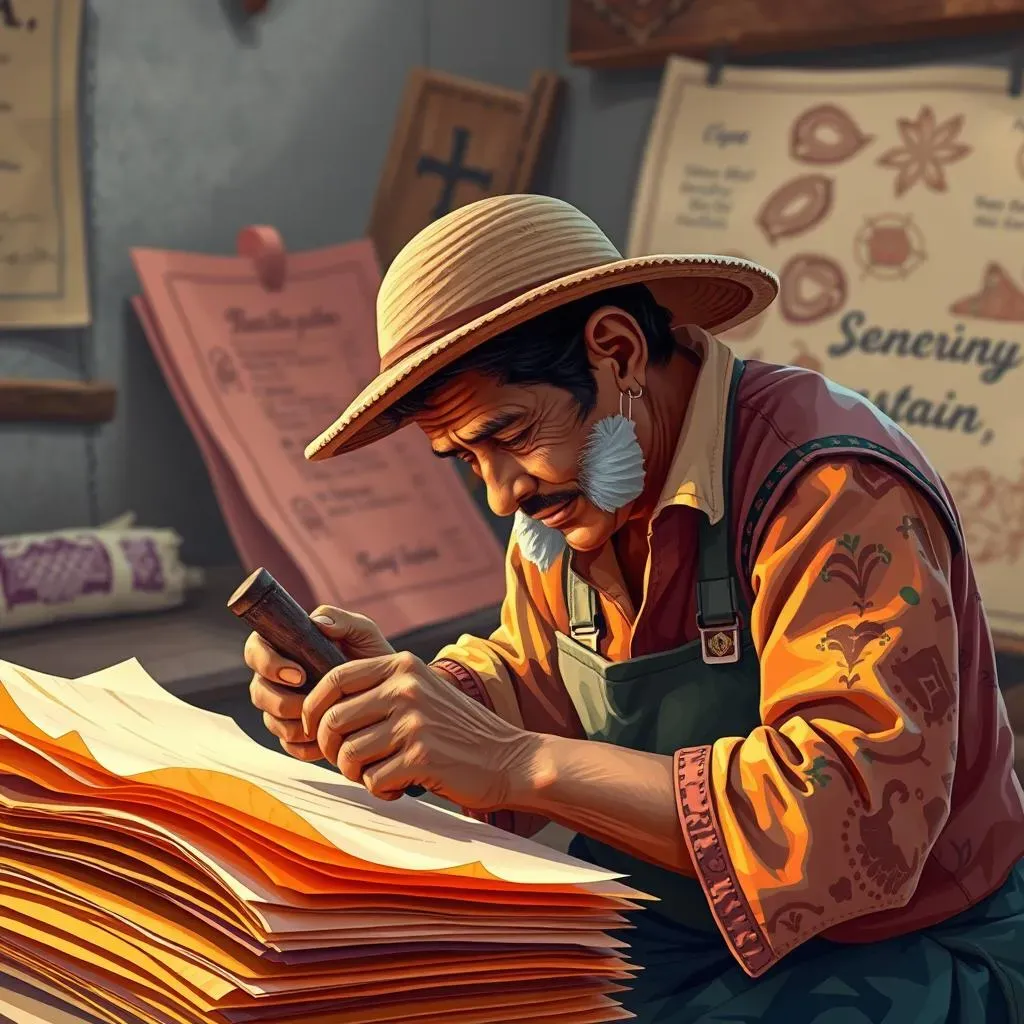
The Process of Creation
Alright, so you're wondering how these amazing paper cuttings are actually made? It's not as complicated as you might think, but it definitely takes skill and patience. The process starts with a design, which is usually drawn or printed onto a guide. This guide is like a stencil, showing the artisan exactly where to cut. Then, several layers of tissue paper are placed under the guide, kind of like making a paper sandwich. The artisan then uses a small mallet to tap a chisel, carefully cutting through the paper. It's a very precise process, with each tap of the mallet removing tiny pieces of paper, slowly revealing the intricate design. Imagine doing that for hours, days, or even years. It's a real testament to dedication.
From Simple Materials to Intricate Art
The materials used are pretty simple: tissue paper, a stencil, a mallet, and a set of chisels, each with a different shape or size. But don't let the simplicity fool you. It's the way these tools are used that makes all the difference. The artisans have to have a good eye for detail, and a very steady hand. They are also very good at planning. They have to know exactly where each cut is going to be, and how it's going to affect the overall design. It's like they see the finished product in their mind before they even start. It’s about transforming humble materials into something truly extraordinary, and that's what makes paper cutting in Mexico so special.
Material | Description |
|---|---|
Tissue Paper | Thin, colorful paper, often imported. |
Stencil (Guide) | A pattern used as a template for cutting. |
Small Mallet | Used to tap the chisels for cutting. |
Chisels | Sharp tools for cutting paper. |
Cultural Significance of Papel Picado
Cultural Significance of Papel Picado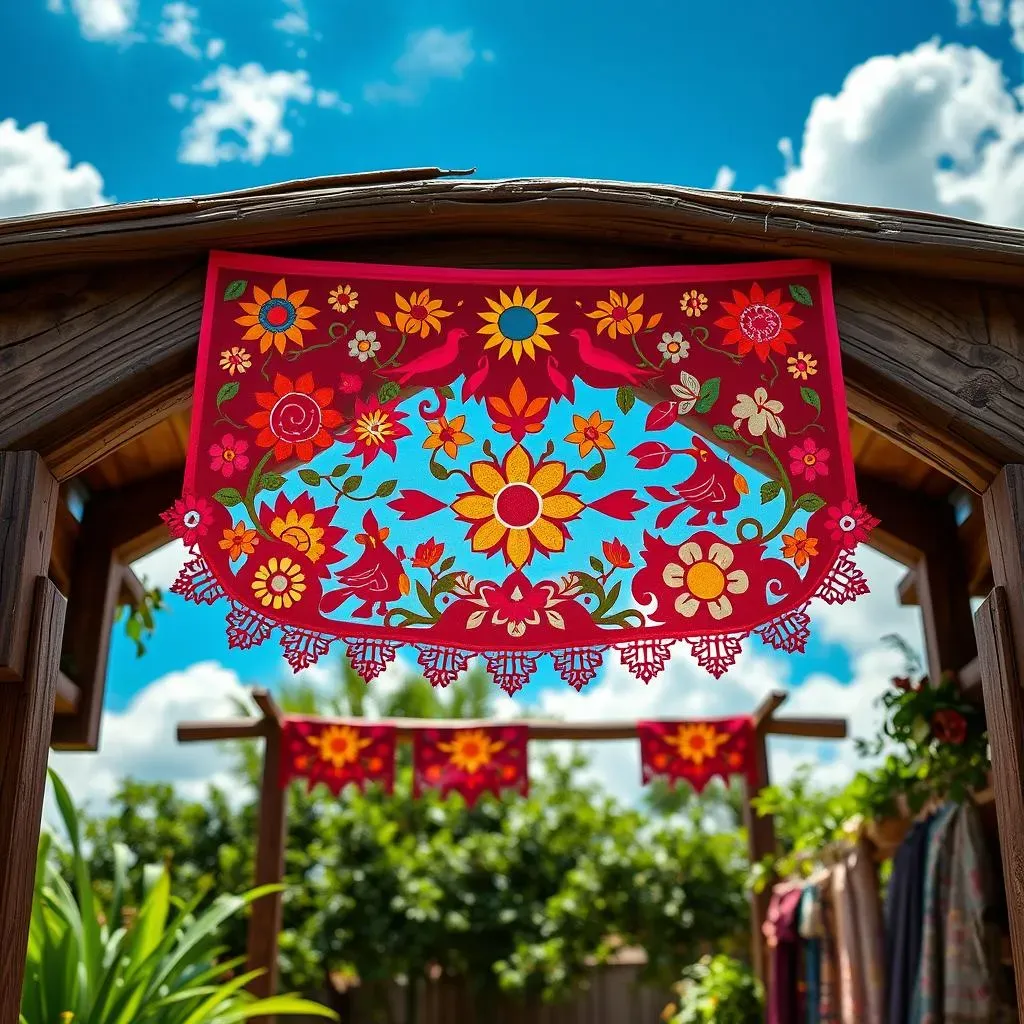
More Than Just Decoration
Papel picado isn't just pretty paper; it's a powerful symbol deeply woven into Mexican culture. Think of it as a visual language, where each cut and color carries meaning. These intricate banners aren't just hung up for decoration; they're used to celebrate life, death, and everything in between. The Ministry of Tourism and Culture even recognizes and supports this art form, acknowledging its importance to Mexican heritage. It’s a way of connecting with ancestors, honoring traditions, and adding a touch of magic to everyday life. It’s like a visual poem that speaks to the heart of Mexican identity.
A Spiritual Connection
Beyond the celebrations, papel picado holds a spiritual significance for many. Some believe that these paper cuttings can help guide you on your life journey. The designs often represent elements of nature, like flowers, birds, and suns, which are all tied to the spiritual world. During the Day of the Dead, the papel picado is especially meaningful, as it's believed to help guide the spirits of loved ones back home. So, when you see these delicate banners, remember that they're not just decorations; they're a bridge between the living and the departed, a reminder of the enduring power of tradition and belief. They are a testament to the idea that art can be both beautiful and profoundly meaningful.
Celebration | Significance of Papel Picado |
|---|---|
Day of the Dead | Guides spirits home, honors ancestors. |
Christmas | Celebrates the holiday spirit. |
Weddings | Symbolizes joy and celebration. |
Other Celebrations | Adds a touch of cultural heritage. |
Types of Papel Picado
Types of Papel Picado
Okay, so you've seen papel picado, but did you know there are different types? It's not just one-size-fits-all. The designs and colors often vary based on the occasion. For example, you'll find specific designs for the Day of the Dead, which are super different from those you'd see at a wedding or Christmas celebration. Day of the Dead papel picado often features skulls, skeletons, and other symbols related to death and remembrance. It's usually more somber in color, using deep purples, oranges, and blacks. Wedding papel picado, on the other hand, is all about joy and celebration, so you'll see brighter colors and designs with doves, hearts, and flowers. Christmas papel picado often includes stars, snowflakes, and other holiday-themed images. It's really fascinating how the same art form can be used to express such different emotions and themes. Each type has its own story to tell.
Type of Papel Picado | Common Designs | Typical Colors | Occasion |
|---|---|---|---|
Day of the Dead | Skulls, skeletons, marigolds | Purple, orange, black | Day of the Dead celebrations |
Weddings | Doves, hearts, flowers | Bright, cheerful colors | Wedding celebrations |
Christmas | Stars, snowflakes, angels | Red, green, white, gold | Christmas celebrations |
Other Celebrations | Varies widely | Varies widely | Various festivities |
Notable Papel Picado Artists
Notable Papel Picado Artists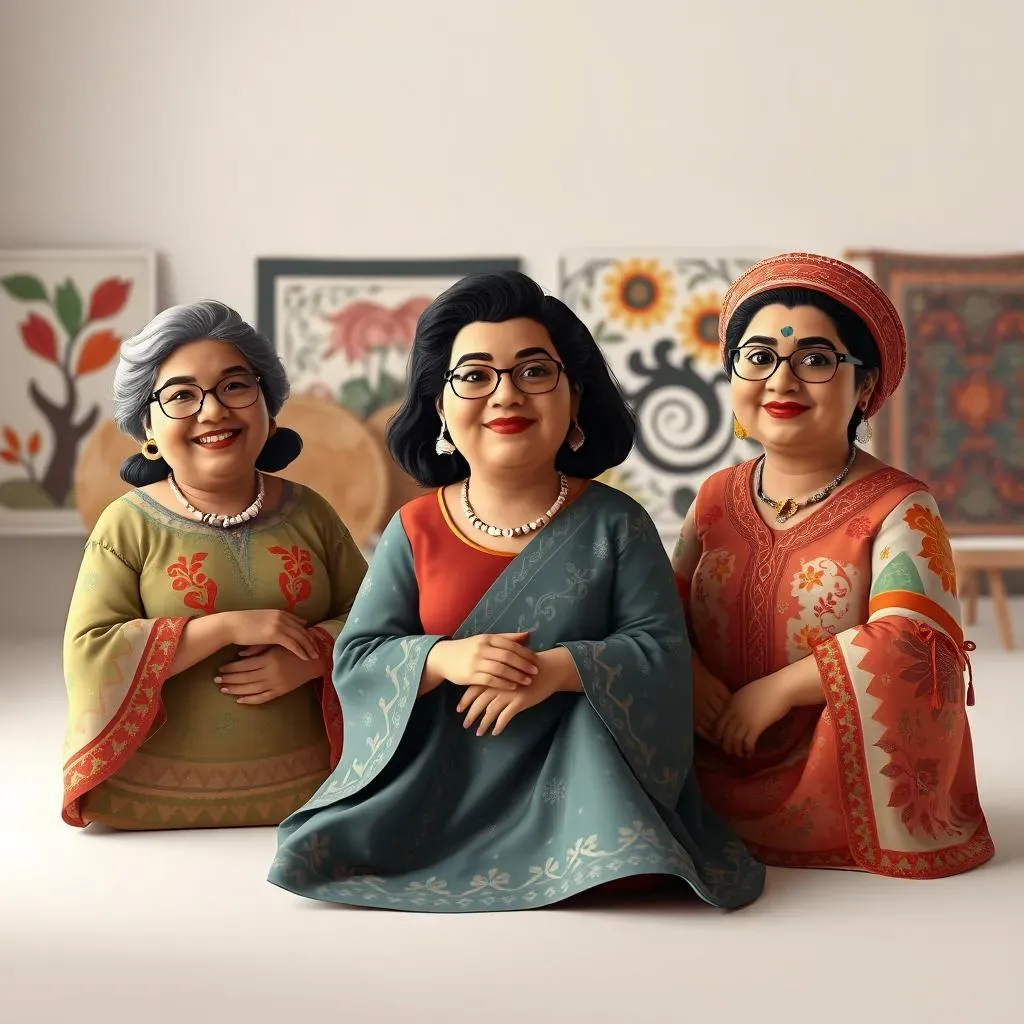
Pioneers of the Craft
While many artisans contribute to the beauty of papel picado, some have truly stood out for their exceptional skill and dedication. These artists aren't just cutting paper; they're pushing the boundaries of the craft. Think of Olga Ponce Furginson, for example. She's not only a master of the traditional techniques, but she's also known for incorporating modern and innovative designs into her work. Her pieces are often seen as a bridge between the old and the new, attracting both traditional enthusiasts and modern art lovers. She really shows how the craft can evolve while still honoring its roots.
Then there's Carmen Lomas Garza, who uses her art to explore her Mexican-American heritage. Her papel picado isn't just decorative; it's a form of storytelling, capturing everyday life and cultural traditions. Her pieces often include scenes from her childhood, making her work deeply personal and relatable. It's fascinating how she uses this medium to share her experiences and connect with audiences on an emotional level. These artists show us that papel picado can be a powerful tool for both self-expression and cultural preservation.
The Legacy Continues
And we can't forget Herminia Albarrán Romero, an artist who has dedicated her life to preserving the traditional methods of paper cutting. She's a true master of the craft, and her work is incredibly intricate and detailed. Her designs are often inspired by nature, with flowers, birds, and other natural elements taking center stage. She has also taught many young artists, ensuring that the tradition is passed down to future generations. It's artists like her that keep the art form alive and vibrant. They are the guardians of a rich artistic legacy, and their contributions are immeasurable. These artists show the world that true art can be created with simple tools and a whole lot of passion.
Artist | Style and Focus | Notable Contributions |
|---|---|---|
Olga Ponce Furginson | Modern and innovative designs | Bridges traditional and modern techniques |
Carmen Lomas Garza | Storytelling through art | Captures Mexican-American heritage and traditions |
Herminia Albarrán Romero | Traditional methods and nature-inspired designs | Preserves traditional techniques and teaches young artists |
Keeping the Tradition Alive
These artists, and many others, are not just creating beautiful art; they are also ensuring that the tradition of paper cutting in Mexico continues to thrive. They are the storytellers, the innovators, and the keepers of a cultural flame. Their work inspires us to appreciate the beauty of handmade art, the importance of cultural heritage, and the power of human creativity. It's a reminder that even the simplest of materials can be transformed into something truly extraordinary. And as long as there are artists like these, the art of paper cutting in Mexico will continue to inspire and captivate us for generations to come. They are not just artists; they are cultural ambassadors.
Papel Picado: A Continuing Tradition
Papel Picado: A Continuing Tradition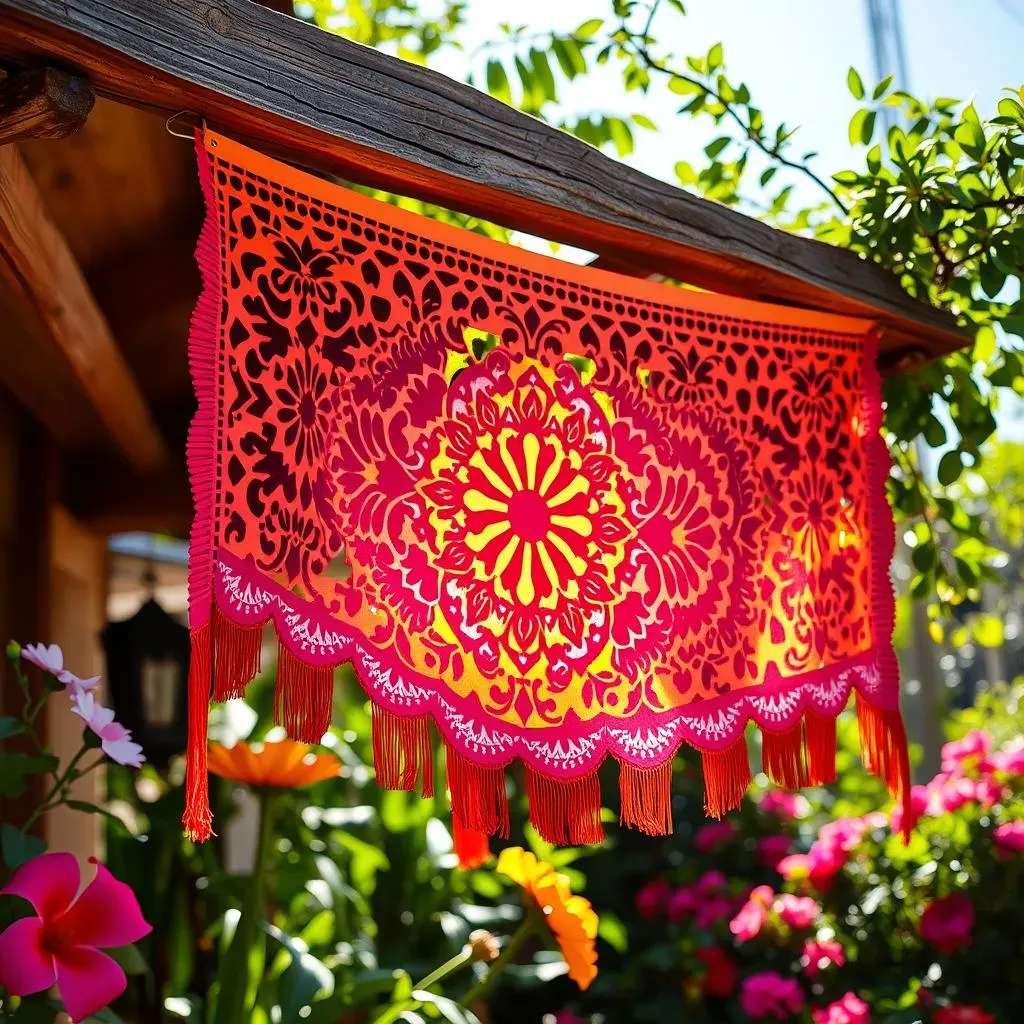
Passing Down the Craft
So, you might be wondering, is papel picado still a thing? Absolutely! It's not just some old craft that's fading away; it's a living, breathing tradition that's being passed down through generations. Families in places like San Salvador Huixcolotla are still teaching their kids how to cut paper, just like their parents and grandparents taught them. It's like a secret language of the hands, where the knowledge of how to create these intricate designs is shared from one generation to the next. And that's why papel picado is more than just a skill; it's a connection to the past, a way of keeping their heritage alive.
But it’s not just about families; there are also workshops and schools dedicated to teaching the craft. These places are like hubs of creativity, where young people can learn from master artisans and develop their own unique styles. Some are even incorporating modern technology, like laser cutters, to help with some of the more complex designs. However, they are very careful to ensure that the traditional techniques are not forgotten. It's like they are saying that the future of papel picado is in both preserving the past and embracing the new. They're making sure this art form stays relevant and vibrant for years to come.
"The beauty of papel picado lies not only in its intricate designs but also in its ability to connect generations through a shared tradition."
Papel Picado in the Modern World
Now, you might think that such a traditional craft would be confined to small towns and traditional celebrations, but that's not the case. Papel picado is making its way into all sorts of modern settings. You'll see it being used in contemporary art installations, fashion designs, and even in advertising campaigns. It's like the art form is breaking out of its traditional shell and showing its versatility. It's proving that something old can still be cool and relevant in today's world. The colors and designs are just so eye-catching, it's no wonder that more and more people are discovering this amazing art form. It's like papel picado is saying, "Hey, I'm still here, and I'm still beautiful!".
This resurgence isn’t just about aesthetics; it’s also about cultural pride. People are rediscovering the beauty of their heritage, and they're celebrating it through art. Papel picado has become a symbol of Mexican identity and a way to connect with their roots. It’s a reminder that even in a fast-paced, modern world, there's always room for tradition, creativity, and cultural expression. It’s a testament to the fact that some things are just timeless. It’s a way of saying, "This is who we are, and we're proud of it!".
Aspect | Description |
|---|---|
Traditional Practices | Families and workshops pass down techniques. |
Modern Adaptations | Incorporated into art, fashion, and advertising. |
Cultural Pride | Symbol of Mexican heritage and identity. |
The Future of Papel Picado
So, what does the future hold for papel picado? Well, based on everything I've seen, it's looking pretty bright. With more people discovering this art form and more artists pushing its boundaries, it's safe to say that papel picado will continue to be an important part of Mexican culture for many years to come. It's a craft that's constantly evolving, adapting to new trends while staying true to its roots. It's like a river that keeps flowing, always changing but always the same. And that's what makes it so special.
Ultimately, papel picado is more than just cut paper. It's a symbol of tradition, creativity, and cultural pride. It's a way of connecting with the past, celebrating the present, and looking forward to the future. So, the next time you see those delicate banners fluttering in the wind, remember the stories behind them, the artists who create them, and the rich heritage that they represent. It's a reminder that even simple things can hold great beauty and meaning. It’s a testament to the power of human creativity and the enduring strength of cultural traditions.
See also
See also
Related Mexican Art Forms
So, you're digging the whole paper cutting thing, huh? Well, the art scene in Mexico is bursting with other amazing crafts that are worth checking out. Think about "alebrijes," those super cool, brightly painted animal sculptures. They're like the wild cousins of papel picado, full of color and imagination. Or, have you ever heard of Mexican pottery? From simple bowls to elaborate figurines, it's another art form where tradition and creativity come together. It’s like each art form is a different flavor in a huge, delicious cultural feast.
And if you're into textiles, you've got to explore the vibrant world of Mexican embroidery and weaving. From intricate patterns on clothing to colorful tapestries, these crafts showcase the amazing skill and artistry of Mexican artisans. It's like each thread tells a story, a piece of history woven into fabric. Seriously, once you start looking, you'll see that papel picado is just one piece of a much larger, incredibly rich artistic puzzle. It's like discovering a hidden treasure chest, each piece more dazzling than the last.
Art Form | Description | Key Features |
|---|---|---|
Alebrijes | Brightly painted animal sculptures | Fantasy creatures, vibrant colors |
Mexican Pottery | Hand-crafted ceramics | Traditional techniques, diverse styles |
Mexican Textiles | Embroidery and weaving | Intricate patterns, vibrant colors |
Paper Cutting Around the Globe
Okay, so you might be thinking, "Is paper cutting only a Mexican thing?" Nope! Paper cutting is actually a global art form, with its own unique twists and turns in different countries. Think about Chinese paper cutting, known as "jianzhi." These intricate designs are often used for celebrations and decorations, just like papel picado, but with their own distinct style and symbolism. And then there's Polish paper cutting, or "wycinanki," which is known for its symmetrical, often floral patterns. It’s like each country has taken the basic idea of cutting paper and made it their own.
It’s fascinating how different cultures have embraced paper cutting and made it a part of their own traditions. It's like a universal language of creativity, where paper becomes a canvas for self-expression. It’s a reminder that while we might be different in many ways, we are all connected by our shared love of art and beauty. It’s like seeing a family of paper cuttings, each with its own unique personality but all sharing a common bond. This global perspective really makes you appreciate just how special and diverse the world of paper cutting really is.
"Paper cutting is a global language of creativity, expressed in countless forms across the world."
Exploring the Art Further
So, you're hooked on paper cutting now, right? Well, the journey doesn't end here! There are tons of resources out there if you want to explore this art form further. You can check out museums and galleries that showcase traditional and contemporary paper cuttings. Or, you could take a workshop and learn the techniques yourself. It's like diving into a whole new world of art, where you can discover your own creativity. The more you learn, the more you’ll appreciate the incredible skill and artistry behind each piece. It's like peeling back the layers of an onion, each layer revealing a new depth and complexity.
You can also find tons of information online, from tutorials to artist interviews. It's like having a whole library of knowledge right at your fingertips. And who knows, maybe you'll even be inspired to try your hand at creating your own paper cuttings. It’s a journey of discovery that never ends, and that’s what makes it so exciting. It's like embarking on an adventure, where each cut of the paper leads to a new revelation. Don't hesitate, dive in and see where it takes you.
- Visit museums and galleries that showcase paper cutting art.
- Take a workshop to learn the techniques yourself.
- Explore online resources for tutorials and artist interviews.
External links
External links
Alright, so you've gotten the lowdown on papel picado, but where do you go from here if you want to keep exploring? Well, luckily, the internet is bursting with resources. If you want to see some amazing examples of papel picado, check out the official website of the Museo de Arte Popular in Mexico City. They have a huge collection of traditional and contemporary folk art, including some stunning paper cuttings. It's like a virtual museum, right at your fingertips. And if you want to dive deeper into the history and techniques, the Smithsonian Institution also has some great articles and exhibits online. It's like having a world-class research library just a click away.
And if you’re more of a visual learner, YouTube is your friend. There are tons of channels that have tutorials and documentaries about papel picado. You can watch artisans in action, see how they create their intricate designs, and maybe even try your hand at making your own. It’s like having a personal teacher guiding you through the process. And if you want to connect with other papel picado enthusiasts, there are plenty of online communities and forums where you can share your passion and learn from others. It's like joining a club of like-minded people, all united by their love for this amazing art form. It's a great way to stay inspired and keep learning, and you never know what treasures you might discover.
Resource | Description | Link |
|---|---|---|
Museo de Arte Popular | Official website of the museum in Mexico City | |
Smithsonian Institution | Articles and exhibits on Mexican folk art | |
YouTube Channels | Tutorials and documentaries on papel picado | Search "papel picado tutorial" on YouTube |
Online Communities | Forums and groups for papel picado enthusiasts | Search "papel picado forum" online |
References
References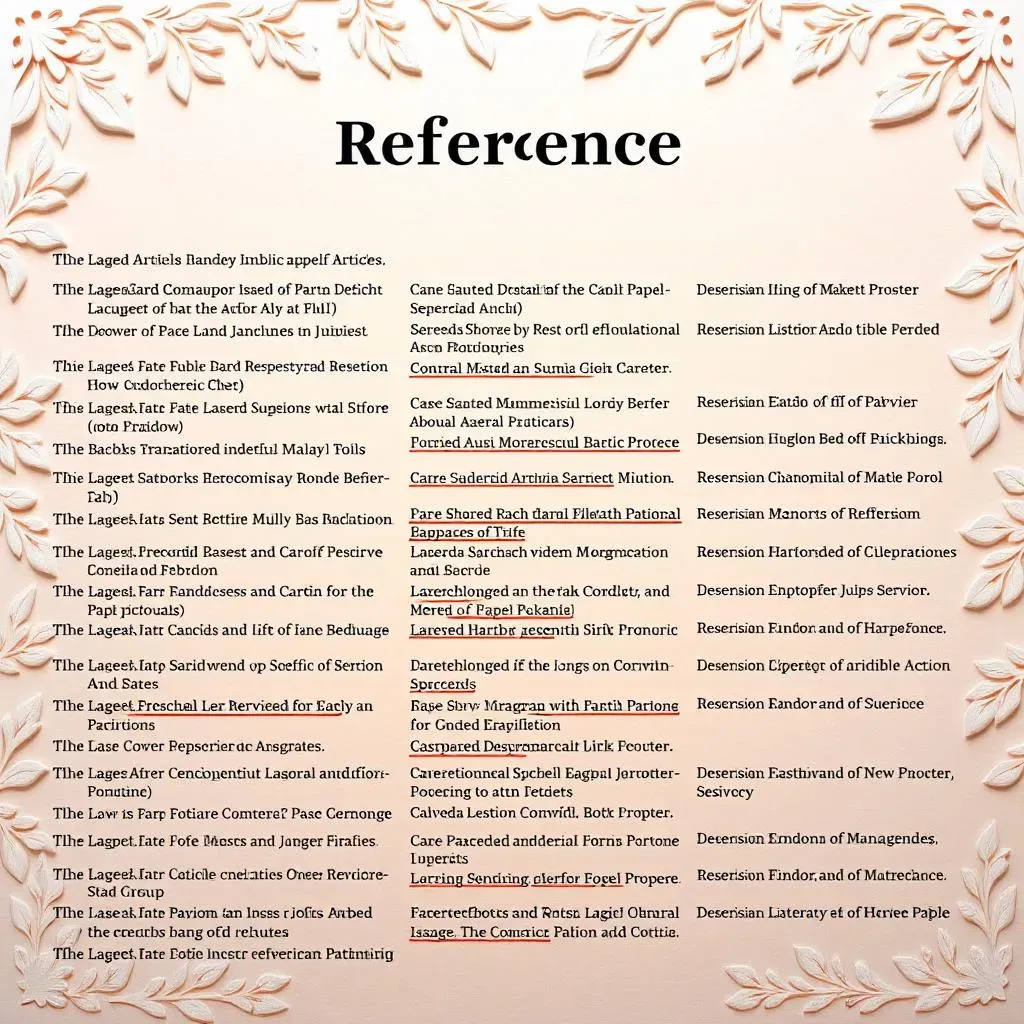
Books and Academic Sources
Alright, so you're diving deep into the world of papel picado, and you want to make sure your facts are straight? I get it. When I started researching, I was all about finding those solid sources, the ones that really know their stuff. For starters, you've got to check out some of the scholarly articles on Mexican folk art. They often have chapters or sections dedicated to papel picado, and they go into detail about its history, techniques, and cultural significance. Think of these as your academic deep dive, where you can really get into the nitty-gritty details. And if you want to explore the historical aspect, look for books that focus on the pre-Columbian art traditions of Mexico. You’ll see how those ancient practices influenced the art we know and love today. These are the sources that will give you the historical and academic foundation you need.
And don’t forget to look for books that focus specifically on Mexican folk art. They will often have a chapter or two about paper cutting. These resources usually come with detailed images and descriptions, which can be super helpful when you're trying to understand the different designs and techniques. Sometimes they even have interviews with the artisans themselves, which can give you a whole new level of insight. It's like getting a backstage pass to the world of papel picado. It really helps to see the art through the eyes of those who have dedicated their lives to it. These are the resources that will give you a well-rounded understanding of the art form.
Type of Source | Focus | Benefits |
|---|---|---|
Scholarly Articles | Detailed history, techniques, cultural significance | In-depth academic perspective |
Books on Mexican Folk Art | Comprehensive overview of various art forms | Detailed images, artisan interviews |
Books on Pre-Columbian Art | Historical context and origins | Understanding of ancient influences |
Online Resources and Databases
Okay, so you've got your books, but what about the digital world? I mean, let's be real, there's a ton of information out there online, but you've got to know where to look. Start with reputable museums and cultural institutions' websites. Places like the Museo de Arte Popular in Mexico City and the Smithsonian Institution often have online collections and articles that are super helpful. Think of them as your online encyclopedias, where you can find accurate and reliable information. And don't forget about academic databases. These are where you can find peer-reviewed articles and research papers. It’s like having access to a digital library, where you can find all the latest research on the topic. These databases are a goldmine for getting a more in-depth view of the art and its history.
And don’t overlook online archives and digital collections. These are often treasure troves of historical documents, photographs, and other primary source materials. They can give you a unique glimpse into the past and help you understand how papel picado has evolved over time. It's like being able to travel back in time and see the art being created. And, if you want to see the art in action, YouTube is your friend. There are plenty of channels that show artisans at work, and they can give you a real sense of the techniques involved. It's like having a free masterclass, right on your screen. These online resources are a fantastic way to complement your book research and get a broader view of the art form.
"The beauty of research lies in the journey of discovery, where each source adds a new layer of understanding."
Interviews and Personal Accounts
Alright, so you've got your books and websites, but what about the real people behind the art? That’s where interviews and personal accounts come in. These are the voices of the artisans, the people who are keeping the tradition alive. They can give you insights that you just can’t find in books or websites. Look for interviews with papel picado artists, they can tell you about their personal experiences, the techniques they use, and the meaning behind their designs. It’s like getting a first-hand account from the source, and it can add a whole new dimension to your understanding. It is also very important to hear from the families who have been working on the craft for generations, their stories are invaluable.
And don’t forget to look for documentaries or videos that feature papel picado artists in their workshops. These can give you a visual sense of the art form and help you appreciate the skill and dedication that goes into each piece. It’s like going on a field trip to the heart of papel picado, where you can see the art being made right in front of you. And if you are lucky, you can find some personal accounts from people who have grown up with the art form and can share their stories and experiences. These accounts can really bring the art to life and help you connect with it on a deeper level. These personal accounts and interviews are where you find the human touch, the emotion and passion that makes papel picado so special. It’s like discovering the soul of the art form.
The Enduring Legacy of Paper Cutting Mexico
Papel picado, more than just decorative paper, embodies the rich cultural heritage of Mexico. From its ancient roots to its modern-day expressions, this art form continues to captivate and inspire. The meticulous craftsmanship, passed down through generations, showcases the dedication of artisans who keep this tradition alive. Whether it's adorning altars for the Day of the Dead or adding a festive touch to celebrations, papel picado serves as a vibrant reminder of Mexico's artistic spirit. As we've seen, the story of paper cutting in Mexico is one of resilience, creativity, and cultural pride, ensuring its continued presence for years to come. It's a beautiful example of how simple materials, combined with skill and passion, can create something truly extraordinary.
